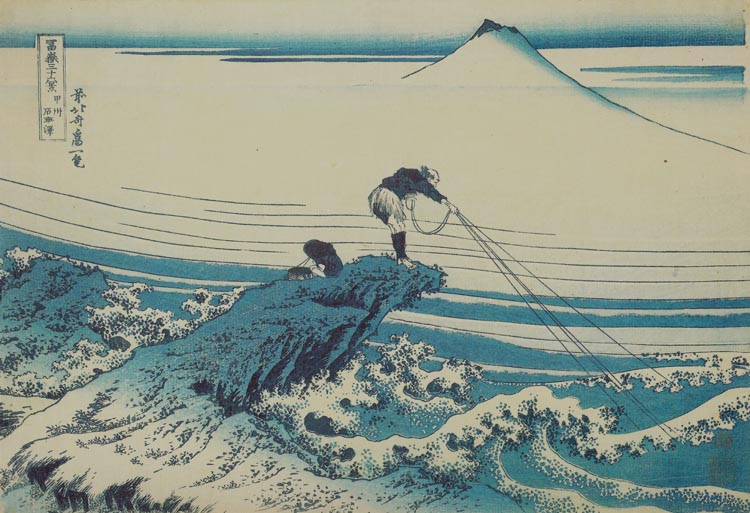Aizuri-e on:
[Wikipedia]
[Google]
[Amazon]
 The term ''aizuri-e'' (Japanese: "blue printed picture") usually refers to Japanese woodblock prints that are printed entirely or predominantly in blue. When a second color is used, it is usually red. Even if only a single type of blue ink was used, variations in lightness and darkness (
The term ''aizuri-e'' (Japanese: "blue printed picture") usually refers to Japanese woodblock prints that are printed entirely or predominantly in blue. When a second color is used, it is usually red. Even if only a single type of blue ink was used, variations in lightness and darkness (
OCLC 61666175
White Falcon in a pine tree, woodblock print by Sawa Sekkyô, 13.5 x 7.75 inches.jpg, ''White Falcon in a pine tree'' by
 The term ''aizuri-e'' (Japanese: "blue printed picture") usually refers to Japanese woodblock prints that are printed entirely or predominantly in blue. When a second color is used, it is usually red. Even if only a single type of blue ink was used, variations in lightness and darkness (
The term ''aizuri-e'' (Japanese: "blue printed picture") usually refers to Japanese woodblock prints that are printed entirely or predominantly in blue. When a second color is used, it is usually red. Even if only a single type of blue ink was used, variations in lightness and darkness (value
Value or values may refer to:
Ethics and social
* Value (ethics) wherein said concept may be construed as treating actions themselves as abstract objects, associating value to them
** Values (Western philosophy) expands the notion of value beyo ...
) could be achieved by superimposing multiple printings of parts of the design or by the application of a gradation of ink to the wooden printing block ('' bokashi'').
The development of aizuri-e was associated with the import of the pigment Prussian blue
Prussian blue (also known as Berlin blue, Brandenburg blue or, in painting, Parisian or Paris blue) is a dark blue pigment produced by oxidation of ferrous ferrocyanide salts. It has the chemical formula Fe CN)">Cyanide.html" ;"title="e(Cyani ...
from Europe in the 1820s. This pigment had a number of advantages over the indigo or dayflower petal dyes that were previously used to create blue. It was more vivid, had greater tonal range and was more resistant to fading. It proved to be particularly effective in expressing depth and distance, and its popularity may have been a major factor in establishing pure landscape as a new genre of ukiyo-e
Ukiyo-e is a genre of Japanese art which flourished from the 17th through 19th centuries. Its artists produced woodblock prints and paintings
Painting is the practice of applying paint, pigment, color or other medium to a solid surfac ...
print.
Early adopters included Hokusai
, known simply as Hokusai, was a Japanese ukiyo-e artist of the Edo period, active as a painter and printmaker. He is best known for the woodblock printing in Japan, woodblock print series ''Thirty-Six Views of Mount Fuji'', which includes the ...
in his '' Thirty-six Views of Mount Fuji'' (1830), most notably in ''The Great Wave off Kanagawa
is a woodblock print by Japanese ''ukiyo-e'' artist Hokusai, created in late 1831 during the Edo period of Japanese history. The print depicts three boats moving through a storm-tossed sea, with a large wave forming a spiral in the centre an ...
'' and ''Kajikazawa in Kai Province
is a woodblock print by the Japanese ukiyo-e artist Hokusai.
It was produced as one of the '' Thirty-six Views of Mount Fuji'' series which was published from in the late Edo period. The image is considered one of the masterpieces of the seri ...
''. Hiroshige
Utagawa Hiroshige (, also ; ja, 歌川 広重 ), born Andō Tokutarō (; 1797 – 12 October 1858), was a Japanese ''ukiyo-e'' artist, considered the last great master of that tradition.
Hiroshige is best known for his horizontal-format l ...
also used Prussian blue extensively in his landscape prints. Other prominent Japanese artists to use it included Keisai Eisen
Keisai Eisen (渓斎 英泉, 1790–1848) was a Japanese ''ukiyo-e'' artist who specialised in ''bijin-ga'' (pictures of beautiful women). His best works, including his ''ōkubi-e'' ("large head pictures"), are considered to be masterpieces of th ...
, Utagawa Kunisada
Utagawa Kunisada ( ja, 歌川 国貞; 1786 – 12 January 1865), also known as Utagawa Toyokuni III (, ), was a Japanese ukiyo-e artist. He is considered the most popular, prolific and commercially successful designer of ukiyo-e woodblo ...
and Utagawa Sadahide
, also known as Gountei Sadahide (), was a Japanese artist best known for his prints in the ukiyo-e style as a member of the Utagawa school. His prints covered a wide variety of genres; amongst his best known are his ''Yokohama-e'' pictures of ...
.
The theory that ''aizuri-e'' production was prompted by the 1842 sumptuary laws known as the Tenpō Reforms
The were an array of economic policies introduced between 1841 and 1843 by the Tokugawa shogunate in Japan. These reforms were efforts to resolve perceived problems in military, economic, agricultural, financial and religious systems.
The changes ...
is no longer widely accepted.Newland, Amy Reigle. (2005). ''Hotei Encyclopedia of Japanese Woodblock Prints.'' Amsterdam: Hotei. OCLC 61666175
Gallery
Sawa Sekkyô Sawa may refer to:
Places
* Sawa, Nepal, a village development committee
* Sawa, Lesser Poland Voivodeship, Poland, a village
* Saveh, sometimes transliterated Sāwa, Iran, a city
* Sawa Lake, Iraq
People
* Sawa (Hrycuniak) (born Michał Hryc ...
,
Kinryuzan Temple in Asakusa from the series Famous Places in the Eastern Capital by Hiroshige II.jpg, ''Kinryuzan Temple in Asakusa'' by Hiroshige II
was a Japanese designer of ukiyo-e art. He inherited the name Hiroshige II following the death in 1858 of his master Hiroshige, whose daughter he married. In 1865 he moved from Edo to Yokohama after dissolving his marriage and began using ...
, mid-19th century. From the series ''Famous Places in the Eastern Capital''.
References
{{Ukiyo-e Ukiyo-e genres